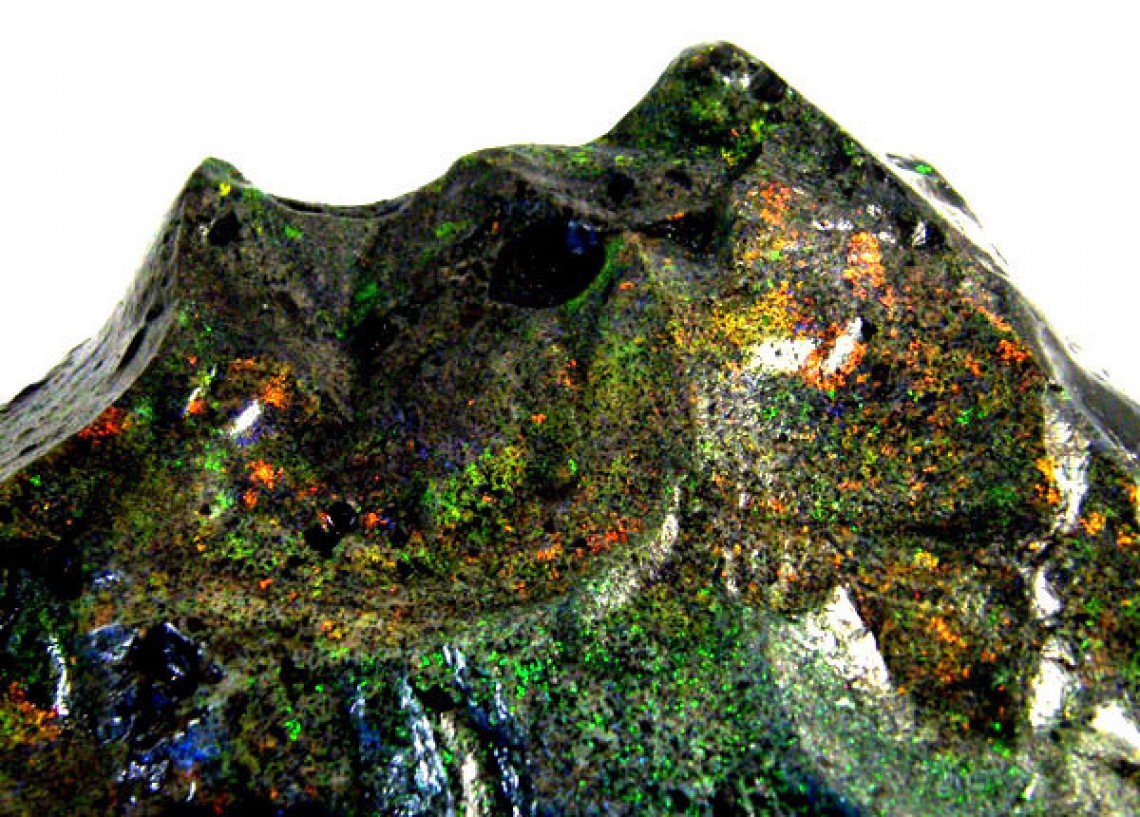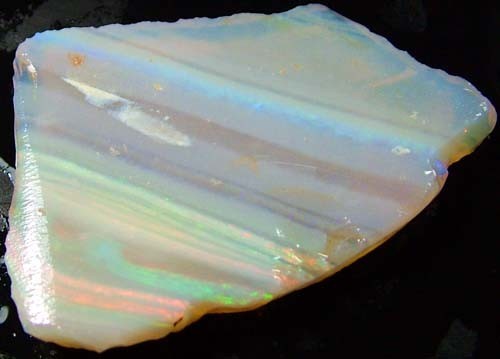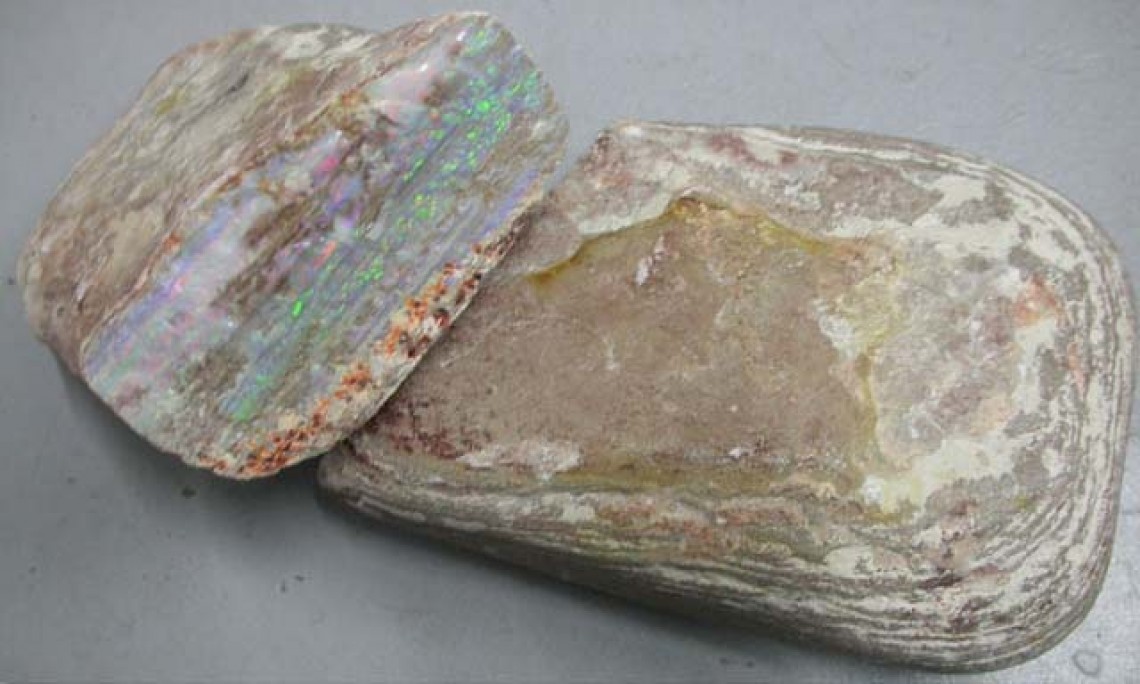
Histoire de l'opale d'Andamooka et comment la traiter

[Temps de lecture : 10 minutes]
En Australie-Méridionale, l'opale a été découverte pour la première fois à Andamooka dans les années 1930. La première opale d'Andamooka a été découverte par Sam Brookes et Roy Sheppard. Surpris par un orage, ils s'étaient abrités sous un arbre lorsqu'une jolie pierre a attiré leur attention. D'autres gisements, plus petits, ont été mis au jour par la suite, notamment à Lambina en 1930 et à Stuart Creek en 1947. L'opale d'Andamooka se trouve dans la mince couche marine de « Bulldog Shale », qui constitue la partie la plus importante du sous-groupe de Marree du Crétacé inférieur.
Résumé
Andamooka est l'un des plus anciens gisements d'opales connus en Australie.
Les opales d'Andamooka ont été utilisées dans les bijoux de la Reine.
L'opale d'Andomooka peut être traitée au sucre pour la noircir et améliorer ses jeux de couleurs.

Opale d'Andamooka célèbre
L'opale d'Andamooka, également connue sous le nom d'« opale de la Reine », a été taillée et sertie sur un collier ras-de-cou en palladium 18 carats en 1954. Elle fut offerte à la reine Élisabeth II lors de son premier voyage d'État officiel en Australie. Aujourd'hui, le collier et les boucles d'oreilles font partie intégrante des joyaux de la couronne de la reine Élisabeth II. L'opale pesait 203 carats.

Découvert en 1930, Andamooka est considéré comme l'un des gisements d'opales les plus importants d'Australie. Il a produit certaines des plus belles pièces ou séries d'opales, comme l'« Opale Matrice d'Andamooka », également appelée « Opale de la Reine », mentionnée précédemment. Le nom Andamooka est dérivé d'un terme aborigène signifiant « Grand Point d'eau ». Située à 600 kilomètres au nord d'Adélaïde, c'est la seule ville australienne dont aucune rue ne porte de nom.

Traitement à l'opale d'Andamooka
Les mines d'opales d'Andamooka sont réputées pour produire de l'opale claire, qui est un compromis entre l'opale blanche et cristalline et est parfois appelée opale « laiteuse ».
L'opale matricielle est une opale perméable originaire d'Andamooka, en Australie-Méridionale. On trouve également à Andamooka une variété d' opale boulder . La roche environnante étant principalement composée de quartzite, l'opale se forme parfois entre ces roches très dures. Ces opales sont appelées les « dames peintes ».

L'opale matricielle d'Andamooka est régulièrement traitée pour améliorer sa couleur grâce à la création d'un corps noir à l'aide de noir de carbone. Ce traitement chimique est appliqué à la pierre entière. À l'extraction, elle peut paraître assez pâteuse, mais grâce à ce procédé de coloration au carbone, elle acquiert finalement une apparence d'opale plus attrayante.
Une fois entièrement traitée, l'opale est connue sous le nom d'opale à matrice traitée d'Andamooka. Le traitement commence par une solution concentrée de sucre et d'eau, suivie d'une phase de trempage dans un bain d'acide sulfurique concentré. Le sucre pénètre la matrice calcaire, puis l'acide la cuit, transformant le sucre blanc entourant les inclusions d'opale en carbone noir. Il en résulte une matrice noircie qui emprisonne les inclusions d'opale et ne diffracte pas la lumière. Certains mineurs ont dérobé ces opales et les ont vendues à l'étranger sous l'appellation d'opale noire de Lightning Ridge. Après la révélation de la supercherie, l'achat d'opale à matrice traitée a connu un certain déclin. Cependant, les couleurs remarquables et la matrice d'un noir profond des plus belles pierres précieuses présentent les caractéristiques qui font la renommée de l'opale noire de Lightning Ridge. Le traitement de ces pierres à matrice repose sur une méthode relativement simple.
 On utilise parfois une résine époxy pour donner aux pierres un bel éclat. Vous pouvez la trouver ici .
On utilise parfois une résine époxy pour donner aux pierres un bel éclat. Vous pouvez la trouver ici .

Os de dinosaure d'Andamooka
Des fossiles et des ossements de dinosaures ont été découverts à Andamooka, et nombre d'entre eux sont aujourd'hui conservés dans des musées. Les dinosaures australiens datent de 100 à 240 millions d'années, ce qui les situe aux périodes jurassique et crétacée. De nombreux pays possèdent des ossements de dinosaures, mais seuls des dinosaures opalisés ont été découverts en Australie.
Prix de l'opale d'Andamooka
L'opale matricielle peut être proposée à un prix tout à fait raisonnable, contrairement à l'opale noire authentique. Il est important que les acheteurs se renseignent auprès d'un vendeur d'opales afin de déterminer s'il s'agit d'une véritable opale noire ou d'une opale matricielle d'Andamooka . 
Comment traiter une opale matricielle d'Andamooka
Le matériel utilisé est très rudimentaire. Pour le chauffage, utilisez une vieille poêle électrique avec thermostat. Il est très important de ne pas surchauffer l'opale, car elle risque de se fissurer si elle est trop chaude.
Versez un mélange d'une tasse de sucre (blanc ou brun, cela ne semble pas faire de différence) dans un bol en Pyrex ou autre bol résistant à la chaleur avec une quantité équivalente d'eau et chauffez jusqu'à ce que le sucre soit dissous.
Réglez la poêle à feu moyen pour la chauffe. Le bol Pyrex peut être placé directement sur la poêle.
Avant tout traitement, l'opale matricielle doit être taillée, façonnée et poncée, mais non polie. Il convient de la sécher soigneusement à l'aide d'un léger chauffage afin d'éliminer toute trace d'humidité présente dans ses pores. Évitez de la toucher avec les doigts, car le sébum de ces derniers pourrait altérer le traitement.
On place ensuite la ou les pierres dans le sirop de sucre et on les laisse cuire pendant au moins 8 heures. La durée de cuisson est assez approximative et dépend de la porosité des pierres. Une matrice très poreuse absorbera le sirop de sucre beaucoup plus rapidement qu'une matrice dense. Je ne sais pas comment évaluer précisément le temps nécessaire, mais 8 heures me semblent un bon point de départ.
Après la cuisson, laissez-les refroidir. Il peut être nécessaire, à ce stade, d'ajouter un peu d'eau à la solution de sucre si elle devient trop épaisse en raison de l'évaporation due à la cuisson.
L'étape suivante est très dangereuse car elle implique l'utilisation d'acide sulfurique hautement concentré. Ce produit est très corrosif et ses vapeurs peuvent également être dangereuses.
Utilisez de l'acide sulfurique à 93 % provenant d'un fournisseur de produits chimiques.
Déposez une petite quantité dans un bol Pyrex et placez-le dans la poêle. La poêle se trouve dans un abri bien aéré.
Lorsque vous versez l'acide dans le bol, il est recommandé de porter des gants en caoutchouc et des lunettes de protection, car l'acide peut provoquer de graves brûlures en cas de contact avec la peau. Soyez donc très prudent. Ne versez jamais l'acide dans l'eau, car la réaction est violente et peut vous éclabousser. Le port d'un masque est également conseillé.
Les pierres sont ensuite délicatement retirées de la solution sucrée à l'aide d'une pince en plastique (et non en métal, car celle-ci réagirait avec l'acide), puis placées avec précaution dans l'acide après avoir laissé égoutter l'excédent de solution sucrée. Il ne faut surtout pas essuyer les pierres à ce stade. On peut alors les faire cuire dans l'acide tiède pendant au moins deux heures. Elles auront alors changé de couleur. On peut ensuite les retirer délicatement avec la pince en plastique et les placer dans un autre récipient contenant une solution de sucre diluée ou une solution de bicarbonate de soude. Ceci afin de neutraliser l'acide.
Après quelques minutes, on peut les admirer, même s'il reste encore le polissage final à effectuer. Tant qu'elles sont humides, on constate l'incroyable transformation qui s'est opérée. Les couleurs de l'opale apparaissent alors clairement.
Si la matrice est assez dense, vous pouvez maintenant polir la pierre. Il est préférable de ne pas utiliser d'oxyde de cérium ni d'oxyde d'étain, car la pâte à polir peut pénétrer dans les pores et former de minuscules points blancs susceptibles d'abîmer la surface. Utilisez un disque de polissage en cuir avec un disque diamanté de grain 50 000.
Il convient d'être particulièrement vigilant et de ne pas exercer une pression excessive, car cela générerait beaucoup de chaleur et risquerait de fissurer la pierre. Les pierres plus poreuses pourraient ne pas se polir du tout. Dans ce cas, il est possible de recouvrir la surface de verre liquide pour obtenir un poli miroir. J'aborderai ce traitement dans un autre article.
N'oubliez pas de vous débarrasser de l'acide avec précaution. Diluez-le très lentement dans l'eau, puis enterrez-le dans le jardin une fois très dilué. N'ajoutez surtout pas d'eau à l'acide, car cela provoquerait des projections et des éclaboussures dangereuses. En cas de contact, rincez abondamment la zone affectée à l'eau. Si vous avez des commentaires sur ce traitement ou sur d'autres méthodes, n'hésitez pas à les partager. Ce procédé a fonctionné pour moi et j'ai obtenu de magnifiques pierres qui ressemblent beaucoup à des opales noires de qualité, pour un coût bien moindre.
Achetez des opales d'Andamooka
Rechercher le Opal Encyclopedia
Enchères associées
Articles Liés
L'opale boulder est l'une des opales les plus sous-évaluées du marché. Découvrez cette opale unique et admirez les magnifiques pierres que nous proposons à la vente.
29th May 2019
Tous les poèmes figurant sur cette page appartiennent à leurs auteurs respectifs. Toute reproduction non autorisée est interdite.
9th May 2018
Le Queensland compte de nombreux gisements d'opales répartis sur plus de 1 000 km. Cliquez pour en savoir plus sur chaque site et découvrir nos magnifiques opales du Queensland à vendre.
5th Mar 2019
Derniers articles
L'opale noire est la variété d'opale la plus recherchée, sa base profonde lui conférant un arc-en-ciel de reflets. Découvrez les usages, les propriétés, l'histoire et la valeur de l'opale noire !
7th Dec 2025
Découvrez comment les opales sont classées et quels facteurs influencent leur prix. De la couleur à la brillance, en passant par la taille et l'origine, apprenez comment chaque type d'opale est évalué, avec des exemples de fourchettes de prix.
19th Jul 2023
Embarquez pour un voyage et découvrez le pouvoir guérisseur des opales grâce à notre auteure invitée, Vivien Schapera, spécialiste des techniques de guérison par les cristaux !
20th May 2023
Catégories d'articles
All there is to know about Opals including Black Opals, Ethiopian Opals & Boulder Opal
14 les articles
Check out our fascinating information and articles on all things amazing in the Opal world
41 les articles
Opal Auctions sellers who are approved as opal Verified Sellers
4 les articles




![39.44 CTS RAINBOW ANDAMOOKA MATRIX STONES -[SEDA7881]](https://liveplatforms-production.b-cdn.net/tenants/oa/uploads/images/990000-994999/991829/5ffd2edb2422a.jpg?width=480&aspect_ratio=1001%3A1000)
![39.62 CTS RAINBOW ANDAMOOKA MATRIX STONES -[SEDA7633]](https://liveplatforms-production.b-cdn.net/tenants/oa/uploads/images/930000-934999/930099/5f508e0f6c331.jpg?width=480&aspect_ratio=1001%3A1000)
![39.87 CTS ANDAMOOKA MATRIX ROUGH SLABS [BY9623]](https://liveplatforms-production.b-cdn.net/tenants/oa/uploads/images/930000-934999/932853/5f58405598f46.jpg?width=480&aspect_ratio=1001%3A1000)
